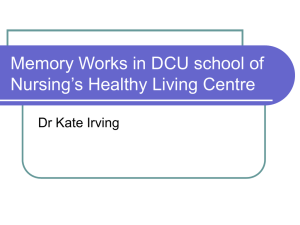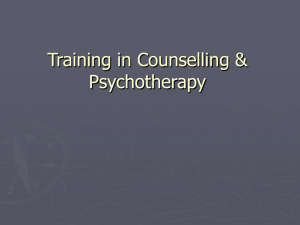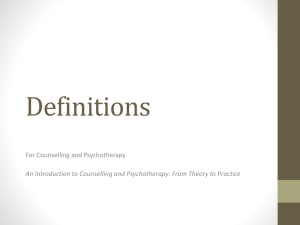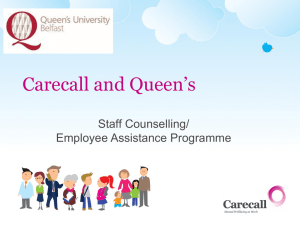Introduction
advertisement
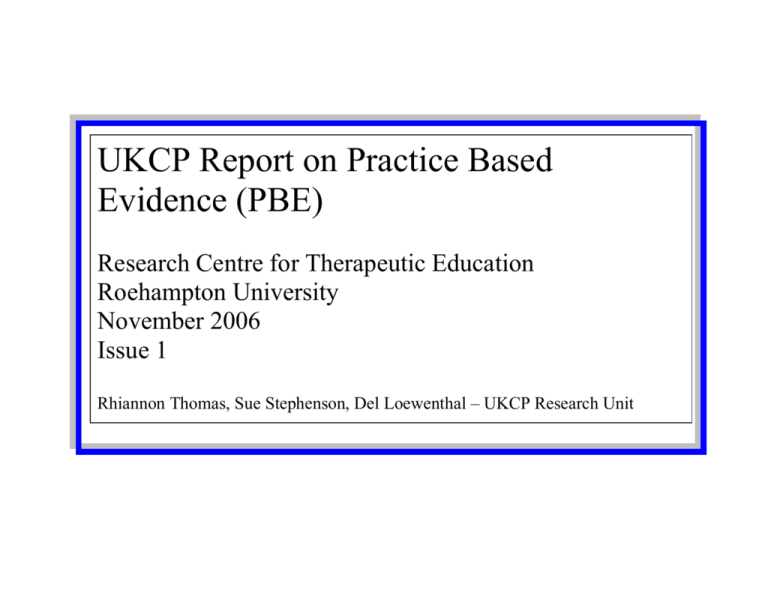
UKCP Report on Practice Based Evidence (PBE) Research Centre for Therapeutic Education Roehampton University November 2006 Issue 1 Rhiannon Thomas, Sue Stephenson, Del Loewenthal – UKCP Research Unit UKCP Report on Practice Based Evidence (PBE) November 2006 ___________________________________________________________________________________________________________ Introduction The purpose of undertaking this work was to produce a report on the findings of a literature search on practice based evidence to establish what kinds of therapy service users feel works. Approach and Scope The work undertaken was as follows: 1. Literature review of published material relating to practice based evidence for each of the following approaches Systemic Psychotherapy Hypno-Psychotherapy Humanistic and Integrative Psychotherapy Psychoanalytic Psychotherapy The published material accessed was as follows: Psychotherapy databases ____________________________________________________________________________________________________________ PBE.doc (Issue 1) Page 2 of 28 UKCP Report on Practice Based Evidence (PBE) November 2006 ___________________________________________________________________________________________________________ 2. Literature on CORE Information from mental health user groups. Identification of the proportion of work undertaken in private practice versus that undertaken in the NHS. ____________________________________________________________________________________________________________ PBE.doc (Issue 1) Page 3 of 28 UKCP Report on Practice Based Evidence (PBE) November 2006 ___________________________________________________________________________________________________________ Practice Based Evidence Research in Psychotherapy and Counselling Introduction Within this literature search has been included both research specifically using the term ‘practice based evidence’ and research which appears essentially practice based in its approach, namely that which is looking specifically at client experience of psychotherapy, or ‘user-led research’, using both qualitative and quantitative research methods and including research from organisations such as the Sainsbury’s Centre for Mental Health and the Mental Health Foundation. The percentages of research undertaken in private practice versus the NHS located by this review are approximately 48% private practice, 42% NHS and 10% not known. Research from outside of the UK was classified either as private practice or not known, as appropriate. Due to the time considerations of this initial three month study, the focus was to be on research into the experiences of service users rather than service providers. The literature search outcomes have been documented as follows: 1. Discussion of the arguments in favour of ‘practice based evidence’ either in place of, or as a complement to, ‘evidencebased practice’ research and literature which defines what is meant by ‘practice based evidence’ in comparison to ‘evidence based practice’. 2. Consideration of practice based evidence which has sought to make direct comparison between the outcomes and/or effectiveness of different therapeutic modalities. ____________________________________________________________________________________________________________ PBE.doc (Issue 1) Page 4 of 28 UKCP Report on Practice Based Evidence (PBE) November 2006 ___________________________________________________________________________________________________________ 3. Review of research literature specifically relating to systemic psychotherapy. 4. Review of research literature specifically relating to hypno-psychotherapy. 5. Review of research literature specifically relating to humanistic and integrative psychotherapy. 6. Review of research literature specifically relating to psychoanalytic psychotherapy. 7. Review of research literature on other practice based evidence research such as issues of outcome and/or effectiveness generally, including practice based evidence looking at the practitioner/client relationship, at reasons for not taking up psychotherapy and counselling appointments and at issues such as self-disclosure/non-disclosure and perceived impact on therapeutic effectiveness. In this last section, the proportion of research focused on process, or ‘process-outcome’– that is research which assumes a fundamental link between process and outcome - appears to outweigh that focused solely on outcome. 8. Some issues raised by the literature review. 1. Arguments in favour of practice based evidence The concept of practice based evidence is that it gives a voice to practitioners and service users, recognising that they have first hand knowledge and experience of what works and alternatively both what needs to change, and how it may change (Ryan, P. & ____________________________________________________________________________________________________________ PBE.doc (Issue 1) Page 5 of 28 UKCP Report on Practice Based Evidence (PBE) November 2006 ___________________________________________________________________________________________________________ Morgan, S. 2004). According to Margison et al (2000), of importance to clinicians is ‘the poor success of RCTs in predicting outcome at the level of the individual case from data summarised at the level of group means’ (averages) in comparison to ‘the best predictor of outcome(which) is initial therapeutic alliance’(Margison et al 2000:124). John McLeod argues that ‘despite the general acknowledgement that it is important for counselling and psychotherapy practice to be informed by research, it is clear that in recent years a widening gap has emerged between research and practice’ (McLeod 2001a:3). According to Aveline (2006:25), a ‘new paradigm of Practice-based evidence is well established’, his position clarified by citing Margison et al (2000) who defined practicebased evidence as the gathering of ‘good-quality data from routine practice’ (Margison 2000:124). Aveline continues that ‘inferences are drawn from naturalistic unselected client populations. The samples may be large, particularly when services pool routinely collected data through organised practice-research networks (PTNs)…Routine monitoring of outcome is an essential component with performance feedback to the clinicians and the service as a whole.’ (Aveline 2006:19) There are a number of papers which have focused on the need for practice based evidence or arguing in favour of consideration of the service user’s perspective regarding therapy they have received, including Barkham et al (2001), Foskett (2001) Macran et al (1999) and Mellor-Clark & Barkham (2003) rather than the tendency to focus on exclusively evidence-based research. This is perhaps not least because of the ‘significant differences’ (Shepherd et al 1994:6) in perspectives which can exist between, for example, service users, family carers and professionals (Shepherd et al 1994). An example of this arguably can be seen in Flitton and Buckroyd (2005) ____________________________________________________________________________________________________________ PBE.doc (Issue 1) Page 6 of 28 UKCP Report on Practice Based Evidence (PBE) November 2006 ___________________________________________________________________________________________________________ where interviews with a student/client, teacher and teaching assistant pre and post 26 weeks of humanistic counselling revealed that the staff were not able to report ‘any significant changes’ yet, the student ‘reported a change in herself and an awareness of the process in the counselling relationship’ (Flitton & Buckroyd 2005: 131). Similarly, Taylor (2005), in studying the counselling experiences of bereaved people found that ‘80% of counsellors were not perceived by participants to have worked with them satisfactorily in relation to their sense of presence of the deceased or in relation to the story of the death itself’ (Taylor 2005: 53). Beeforth et al (1994:1) suggested that ‘user researchers bring a new and different perspective, which generates new ideas and constructs and enhances the quality of the whole research process’. However, just as with evidence-based practice, there are many definitions, philosophies, and research methods associated with the term “practice-based evidence” although what is undoubtedly held in common is the ‘patient centred’ nature of the research focus. In these papers listed above such as Barkham et al (2001) and others such as Conway et al (2003), the distinction between practice based evidence and evidence based practice is clearly outlined. Sackett et al (1997) define evidence based practice as ‘the conscientious, explicit and judicious use of current best evidence in making decisions about the care of individuals.’ (Sackett et al 1997:2). Simons et al (2003) argues in favour of practice based evidence in terms of the concept of a ‘situated generalisation’, in reference to the argument that the generalisations made about practice from ‘evidence-based’ research often are not applicable to individual cases. Whilst practice-based evidence research aims to be no less rigorous that evidence-based practice, the primary difference between the two approaches appears to be the degree of focus on the experiences of service users and providers in ____________________________________________________________________________________________________________ PBE.doc (Issue 1) Page 7 of 28 UKCP Report on Practice Based Evidence (PBE) November 2006 ___________________________________________________________________________________________________________ comparison to externally set criteria of assessment. Papers such as Lucock et al (2003) discuss how to conduct practice based evidence specifically using the Clinical Outcomes in Routine Evaluation - Outcome Measure (CORE-OM) as a complement to the evidence based practice paradigm. It appears that researchers using the CORE-OM have been the more prolific in applying the principles of practice based evidence – the gathering of ‘good quality data from routine practice’ (Margison 2000:124 [see above]) - to psychotherapy outcome studies and in using quantitative data analysis and according to Aveline (2006), CORE is ‘one of the most promising’ of several ‘reliable, relevant and sensitive psychometric systems for routine use’ which have been developed. Another such approach is the Psychological Outcome Profiles or ‘PSYCHLOPS’ (Ashworth et al 2004) which argues that ‘focusing on the problems of greatest priority to the client might prove a sensitive measure of improvement after counselling’ (Ashworth et al 2004: 27). In contrast to these approaches however, the majority of practice based evidence research, that is, research which is focused on experiences of therapy from the perspective of the patient or client, appears to be qualitative and focused on process rather than outcome. Within this however, it is perhaps also important to note literature which highlights the difficulties in using ‘self-report questionnaires’ in research into therapeutic change (McLeod 2001b). McLeod focuses specifically on three main problematic aspects, firstly that ‘questionnaires are completed in a social setting that itself changes as a result of therapy’; secondly that ‘the experience of psychotherapy changes the way that clients make sense of questionnaire items (the ‘response shift’ phenomenon) and thirdly that ‘the ____________________________________________________________________________________________________________ PBE.doc (Issue 1) Page 8 of 28 UKCP Report on Practice Based Evidence (PBE) November 2006 ___________________________________________________________________________________________________________ conceptualisation of the person implicit in questionnaire design is not compatible with the conceptualisation of persons espoused by most contemporary therapeutic approaches’ (McLeod 2001b:215) Some proponents of practice based evidence suggest that qualitative methods are the most appropriate for example Margison et al (2000) who observe that practice based evidence is particularly well-suited to questions about the quality of interventions, including the extent to which they are comprehensive, relevant, acceptable, and accessible. Through naturalistic inquiry, practice-based research has also been used to examine unexpected results, such as early improvement related to hope, therapeutic engagement, or other common factors across interventions (Stiles et al 2003). 2. Comparative Practice based evidence Recently, ‘The Depression Report: A New Deal for Depression and Anxiety Disorders’ (Layard et al 2006) highlighted the NICE guideline that ‘most people with mental illness should be offered the choice of psychological therapy’ (Layard et al 2006: 2) and discussing specifically Cognitive Behavioural Therapy in relation to its positive impact on depression, anxiety and schizophrenia, arguing – from examination of a number of individual research studies - that ‘CBT will on average produce significant improvement’ (Layard et al 2006:7). In relation to practice based evidence research comparing different psychotherapies which has been carried out into the experiences of service users, Stiles et al (2006) using the CORE-OM, surveyed over 1300 service users of Cognitive ____________________________________________________________________________________________________________ PBE.doc (Issue 1) Page 9 of 28 UKCP Report on Practice Based Evidence (PBE) November 2006 ___________________________________________________________________________________________________________ Behavioural, Person-Centred and Psychodynamic therapies, concluding in agreement ‘with previous findings that theoretically different approaches tend to have equivalent outcomes’ (Stiles et al 2006: 555). This concurs with the ‘dodo bird’ or ‘equivalent outcome’ finding which has been the conclusion of many other forms of research into psychotherapy outcomes (Shapiro 1995; Luborsky & Singer 1975). The different conclusions of Layard et al (2006) and Stiles et al (2006) can perhaps be explained with reference to the different natures of the research – one an overview of existing research, the other a stand-alone research project. However, one difference between Cognitive-Behavioural clients and others according to Gershefski et al (1996) was that CBT clients ‘gave responses coded as reflecting aspects that were specific to the treatment they received significantly more often’ than clients of other therapeutic modalities (Gershefski et al 1996:233). 3. Systemic Psychotherapy Regarding systemic psychotherapy, the majority of practice based research appears to be primarily focused on process rather than specifically on outcome, for example O’Connor et al (1997) who defined several categories of the client’s experience, namely ‘externalizing conversation, developing the alternate story, personal agency, reflecting/consulting teams, building a wider audience, and the helpful and unhelpful aspects of the therapy’ (O’Connor et al 1997: 479). The ‘notation that families found the therapy to be very effective’ (O’Connor et al 1997:479) is also included, but outcome in this research is implicitly understood to be consequential of ____________________________________________________________________________________________________________ PBE.doc (Issue 1) Page 10 of 28 UKCP Report on Practice Based Evidence (PBE) November 2006 ___________________________________________________________________________________________________________ process. An exception to this includes Bryan et al (2004) who considered the effects of client and therapist gender/ethnicity and matches on other variables and compared client perceptions of therapy outcome with therapist views. Similarly, Bowman & Fine (2000) whose study of client perception of helpful and unhelpful aspects of couple therapy concluded three main influences: Whether or not they felt they were given choices regarding ideas and ways of working which fit them; whether or not they were working with a therapist they trusted; whether or not they were developing new ideas about the couple relationship. With implications for outcome, Vossler (2004) considered, with reference to family counselling in Germany, the participation of children and adolescents, finding that adolescents feel partly excluded and insufficiently integrated into the counselling process. 4. Hypno-psychotherapy In relation to practice-based evidence research specific to hypno-psychotherapy, this literature search did not locate any relevant papers. 5. Humanistic and Integrative Psychotherapy In relation to humanistic and integrative psychotherapy, research which is practice based is dominated by research which has focused on process rather than outcome, for example Paulson, Everall & Stuart (2001) whose qualitative study firstly considered the ____________________________________________________________________________________________________________ PBE.doc (Issue 1) Page 11 of 28 UKCP Report on Practice Based Evidence (PBE) November 2006 ___________________________________________________________________________________________________________ experiences of eight adult clients by asking what was ‘unhelpful or hindering’ about counselling and ‘what would have made counselling more helpful? (Paulson et al 2001:53) and then found three ‘core aspects’ of unhelpful therapy, specifically counsellor behaviours, external or structural barriers and finally client variables. Other research has considered specifically the client ‘experience’, for example Marchant and Payne (2002). In this study, collaboration between the researcher and the participants led to an identification of two of the six ‘core' conditions identified by Rogers as being of real importance to clients with anorexia: unconditional positive regard and congruence. According to Marchant and Payne (2002) the context in which counselling is offered was also of crucial significance to these clients. 6. Psychoanalytic Psychotherapy With reference specifically to psychoanalysis, Leuzinger-Bohleber, Stühr, Rüger and Beutel (2003) have conducted ‘multi- perspectival’ research, mixing practice based evidence with evaluations of the patients’ “analysts, independent psychoanalytic and non-psychoanalytic experts” (Leuzinger-Bohleber et al 2003: 263). This research found that 70-80% of patients achieved (an average of 6.5 years after treatment) ‘good and stable psychic changes’. Other papers considering outcome following psychoanalytic treatment include Midgley, Target and Smith (2006) although in comparison with Leuzinger-Bohleber et al (2003), the focus is specifically on the experiences of the patient and in this sense could be argued to be more ‘practice based’ evidence. Midgley et al (2006) in ____________________________________________________________________________________________________________ PBE.doc (Issue 1) Page 12 of 28 UKCP Report on Practice Based Evidence (PBE) November 2006 ___________________________________________________________________________________________________________ qualitative analysis of semi-structured interviews with 27 adults who had as children been seen in psychoanalytic treatment at the Anna Freud centre between 1952 and 1980, found that for some of the interviewees, one of the most important factors in a successful long term outcome was the ‘development of a self-analytic function’ (Midgley et al 2006:257). In particular with this research, several specific themes were established which described the different ways in which the research participants felt the experience of psychoanalytic treatment impacted upon their lives. Winter et al (2003), exploring the effectiveness of a voluntary sector psychodynamic counselling service using data from two studies; one using the General Health Questionnaire and Personal Opinion Survey and the second, CORE and WPF questionnaires CQ01 and CQ02 found ‘clinically as well as statistically significant’ evidence pointing to the ‘effectiveness of the psychodynamic counselling service provided by WPF and its affiliated counselling centres’ changes that are ‘largely maintained following counselling’ (Winter et al 2003: 266). WPF was chosen as the focus for the research as it is ‘believed to be the largest voluntary sector provider of individual psychodynamic counselling in England and which has a client group with comparable psychiatric morbidity to clients attending National Health Service psychiatric outpatient services’ (Winter et al 2003: 262) and as such it is assumed would provide results which are representative of those which would be discovered in alternative settings. It is important to note that there was no obvious researcher allegiance in relation to this study which would have impacted upon the findings (Luborsky et al 2003). In contrast, the Women’s Therapy Centre research project (Morris 2005) – a primarily qualitative study carried out in 2003 – 2004 - exploring what the clients ‘did or did not gain from the experience’ of psychoanalytic psychotherapy was carried out by ____________________________________________________________________________________________________________ PBE.doc (Issue 1) Page 13 of 28 UKCP Report on Practice Based Evidence (PBE) November 2006 ___________________________________________________________________________________________________________ researchers working for the centre itself and the findings may arguably need to be considered in this light. Using evidence gathered from 47 service users, the project considered experiences of therapy itself in terms of it’s perceived effectiveness (29 out of the 47 reported a perceived positive outcome), but also aspects of therapy as diverse as the users’ experiences of fitting therapy into their lives, making contact with the centre, the building and atmosphere, disability access, timing of sessions, payment, interruptions and travelling to and from the Centre (Morris 2005). Outside of outcome research, research into process (or perhaps more accurately ‘process-outcome’) in psychoanalytic or psychodynamic therapy has included such as Arthern & Madill (2002) who have considered clients’ views on how, for example transitional objects ‘work’. Others include Bowden (2002) who describes a study of patients’ attitudes to group therapy at the time of referral for psychotherapy, an aspect of patient experience which arguably carries direct implications for outcome. 7. Other practice based evidence research Overwhelmingly however, practice based evidence in psychotherapy research has not distinguished between different types of therapy in terms of the specific connection between therapeutic modality and an apparently positive therapeutic outcome. These include Gershefski et al (1996) and Miller (2002) whose study of client experiences of an ‘in-house’ police counselling service highlighted the service users’ general satisfaction, whilst Rennie (2001) again points to the primacy of the patient-therapist ____________________________________________________________________________________________________________ PBE.doc (Issue 1) Page 14 of 28 UKCP Report on Practice Based Evidence (PBE) November 2006 ___________________________________________________________________________________________________________ relationship rather than therapist orientation in perceived outcome of therapy. Similarly, in considering specifically adolescent clients, Everall and Paulson (2002) highlighted that a ‘strong alliance was found to be necessary in that the perception of the therapist as accepting, supportive and trustworthy influenced evaluation of the appropriateness of therapeutic tasks and goals’ (Everall & Paulson 2002:78), a conclusion supported by Fitzpatrick et al (2006) who identified positive feelings in relation to the therapist helping to enhance the exploratory process. There is a significant amount of research which is looking not at specific modalities of therapy, but at specific client groups, not least Mair’s (2003) study of gay men’s experiences of therapy, Marchant & Payne’s (2002) research into the experiences of anorexic clients and Setiawan’s (2006) exploration of counselling in relation to Asian students. In addition to this, there is also a significant amount of research which although not considering outcome and/or effectiveness directly, has used practice-based evidence to consider factors which have implications for the effectiveness of therapy; specifically research into client attitudes to therapy and client experience of the process of therapy, which could be argued to fall into the category of process-outcome research. These include Snape et al (2003) who considered the reasons given for not taking up counselling appointments, a significant influence on both counselling process and effectiveness, citing General Practitioner support, receiving information about the service and realistic expectations of waiting times as most often impacting upon the possibility of ‘feeling better’ (Snape et al 2003: 239). Also Audet & Everall (2003) who found both hindering and beneficial effects of therapist disclosure depending on the context in which it occurred and the way in which it was delivered by the counsellor and in a similar area of study ____________________________________________________________________________________________________________ PBE.doc (Issue 1) Page 15 of 28 UKCP Report on Practice Based Evidence (PBE) November 2006 ___________________________________________________________________________________________________________ Hanson (2005) who considered counsellor self-disclosure and non-disclosure in relation to the impact on clients. Hanson argued that ‘disclosures were twice as likely to be experienced as helpful and non-disclosures twice as likely to be unhelpful’ and suggesting ‘that skill, or lack of it, was the intervening variable that affected the perceptions of both techniques’ (Hanson 2005: 96). Along the same lines, research by Thomson & Hill (1993) considered client perceptions of therapist competence, finding that facilitative therapists were most likely to be given a positive rating, whilst those seen as ‘detracting’ were seen negatively. 8. Some issues raised by the literature review This review raises questions regarding the nature of evidence, for example, the use of case study as a method which arguably is an account of both process and outcome and also the importance of smaller scale qualitative studies in informing debates on effectiveness in comparison to larger projects such as Roy-Byrne et al (2005). The majority of the literature researching non-Cognitive Behavioural Therapies, with notable exceptions such as research using the CORE-OM, discussed below, has tended to be qualitative and focused on process rather than explicitly on outcome with any discussion of outcome seen as inextricably linked to process. In addition, there is a significant proportion of the literature which concentrates on specific client groups without attempting to generalise about the population at large, or on detailed aspects of the client experience rather than seeking to describe an overall experience. Within this, the client/therapist relationship is given particular attention. The review of current research also raises the issue of perception of ‘wellness’ with researchers working outside the medical model arguably looking for other indicators of wellbeing than ____________________________________________________________________________________________________________ PBE.doc (Issue 1) Page 16 of 28 UKCP Report on Practice Based Evidence (PBE) November 2006 ___________________________________________________________________________________________________________ those approaching therapy research from a medicalised perspective. With this in mind, authors such as Robinson (2002), in consideration of the principles of transparency, accessibility, accountability and protection in relation to measurement and outcomes in an NHS psychotherapy context, suggest that outcome measurements can in fact impede delivery of good services, risk being essential to the process of psychotherapy (Robinson 2002: 37). ____________________________________________________________________________________________________________ PBE.doc (Issue 1) Page 17 of 28 UKCP Report on Practice Based Evidence (PBE) November 2006 ___________________________________________________________________________________________________________ References Arthern, J. & Madill A. (2002) ‘How do transitional objects work? The Client’s view’ Psychotherapy Research Vol. 12, No. 3 pp. 369 - 388 Ashworth, M., Shepherd, M., Chisley, J., Matthews, V., Wright, K., Parmentier, H., Robinson, S., Godfrey, E. (2004) ‘A client generated psychometric instrument: The development of ‘PSYCHLOPS’ Counselling Psychotherapy Research Vol.4, No.2 pp. 27-31 Audet, C. & Everall, R.D. (2003) ‘Counsellor self-disclosure: Client informed implications for practice’ Counselling Psychotherapy Research Vol. 3 No. 3 pp. Aveline, M. (2006) ‘Issues in Psychotherapeutic Research’ in D. Loewenthal & D.Winter (eds.) What is Psychotherapeutic Research London: Karnac pp.3-28 Barkham, M., Margison, F., Leach, C., Lucock, M.P., Mellor-Clark, J., Evans, C., Benson, L., Connell, J., Mellor-Clark, J., Audin, J., & McGrath, G. (2001) ‘Service profiling and outcomes benchmarking using the CORE-OM: Toward practice-based evidence in the psychological therapies’ Journal of Consulting and Clinical Psychology Vol. 69 pp.184-196 ____________________________________________________________________________________________________________ PBE.doc (Issue 1) Page 18 of 28 UKCP Report on Practice Based Evidence (PBE) November 2006 ___________________________________________________________________________________________________________ Barkham, M., Mellor-Clark, J., Connell, J, Cahill, J. (2006) A core approach to practice-based evidence: A brief history of the origins and applications of the CORE-OM and CORE System Counselling Psychotherapy Research Vol. 6, No. 1 pp. 3-15 Beeforth, M., Conlan, E., Graley, R. (1994) Have we got views for you: user evaluation of case management London: Sainsbury’s Centre for Mental Health Blazdell, J. (1999) ‘User-led research in mental health: An update from the Mental Health Foundation’ Updates Vol 1, Issue 8. http://www.mentalhealth.org.uk/page.cfm?pagecode=PBUP0108 Bowden, M. (2002) ‘Anti-group attitudes at assessment for psychotherapy’ Psychoanalytic Psychotherapy Vol. 16 No. 3 pp. 246-258 Bowman, L & Fine, M. (2000) ‘Client Perspectives of Couples Therapy: Helpful and Unhelpful Aspects’ American Journal of Family Therapy Vol. 28.4 pp. 295-310 Boyd, J. (2005) ‘Where two worlds meet: An exploration of the client’s experience of dream-work in time limited therapy’ Psychodynamic Practice Vol. 11 No. 2 pp. 189-204 Bryan, L., Dersch, C., Shumway, S. & Arredondo, R. (2004) ‘Therapy outcomes: Client perception and similarity with therapist view’ American Journal of Family Therapy Vol. 32.1 pp. 11-26 ____________________________________________________________________________________________________________ PBE.doc (Issue 1) Page 19 of 28 UKCP Report on Practice Based Evidence (PBE) November 2006 ___________________________________________________________________________________________________________ Campbell, J. (1989) The Wellbeing project: Mental Health Clients speak for themselves California Department of Mental Health Conway, S., Audin, K., Barkham, M., Mellor Clark, J. & Russell, S. (2003) ‘Practice Based Evidence for a brief-time intensive multimodal therapy, guided by group analytic principles and method’ Group Analysis Vol. 36, No 3, pp.413-43 Duncan, B. & Miller, S. (2000) The Heroic Client: Doing Client-directed, outcome informed therapy San Francisco: Jossey-Bass Inc. publishers Evans, C., Connell, J., Barkham, M., Margison, F., McGrath, G., Mellor-Clark, J. & Audin, C. (2002) ‘Towards a standardised brief outcome measure: psychometric properties and utility of the CORE-OM’ British Journal of Psychiatry Vol 180 pp. 51-60 Everall, R.D & Paulson, B.L. (2002) ‘The therapeutic alliance: Adolescent perspectives’ Counselling Psychotherapy Research Vol. 2 No. 2 pp. 78-87 Fitzpatrick, M., Janzen, J., Chamodraka, M. & Park, J. (2006) ‘Client critical incidents in the process of early alliance development: A positive emotion-exploration spiral’ Psychotherapy Research Vol. 16 No. 4 pp. 486-498 Flitton, B. & Buckroyd, J. (2005) ‘Counselling children and young people who attend a school for children with complex needs: A case study’ Counselling Psychotherapy Research Vol. 5 No. 2 pp. 131-137 ____________________________________________________________________________________________________________ PBE.doc (Issue 1) Page 20 of 28 UKCP Report on Practice Based Evidence (PBE) November 2006 ___________________________________________________________________________________________________________ Foskett, J. (2001) ‘What of the client’s-eye view? A response to the millennium review’ British Journal of Guidance and Counselling Vol. 29 No. 3 pp. 345-350 Gershefski, J.J., Arnkoff, D.B., Glass, C.R., Elkin, I. (1996) ‘Clients’ perspectives of treatment for depression I: Helpful aspects’ Psychotherapy Research Vol. 6, No. 4 pp. 233-248 Hanson, J. (2005) ‘Should your lips be zipped? How therapists self-disclosure and non-disclosure affects clients’ Counselling Psychotherapy Research Vol. 5 No. 2 pp. 96-104 Klein, M.J. & Elliot, R. (2006) ‘Client accounts of personal change in process-experiential psychotherapy: A methodologically pleuristic approach’ Psychotherapy Research Vol. 16 No. 4 pp. 91-105 Layard, R., Bell, S., Clark, D., Knapp, M., Meacher, B., Priebe, S., Thornicroft, G., Turnberg, L., Wright, B. (2006) ‘The Depression Report: A New Deal for Depression and Anxiety Disorders’ London: LSE Centre for Economic Performance http://cep.lse.ac.uk/textonly/research/mentalhealth/DEPRESSION_REPORT_LAYARD.pdf ____________________________________________________________________________________________________________ PBE.doc (Issue 1) Page 21 of 28 UKCP Report on Practice Based Evidence (PBE) November 2006 ___________________________________________________________________________________________________________ Leuzinger-Bohleber, M., Stühr, U, Rüger B, and Beutel, M. (2003) ‘How to study the quality of Psychoanalytic treatments and their long-term effects on patients’ wellbeing: A representative, multi-perspectival follow up study’ International Journal of Psychoanalysis Vol 84, No. 2 pp. 263-290 Luborsky, L. & Singer, B. (1975) Comparative studies of psychotherapies. Is it true that "everyone has won and all must have prizes"? Archives of General Psychiatry Vol. 32, No. 8 Luborsky, L., Rosenthal, R., Diguer, L, Andrusyna, T., Levitt, J.T., Seligman, D.A., Berman, J.S., & Krause, E.D. (2003) ‘Are some psychotherapies much more effective than others?’ Journal of Applied Psychoanalytic Studies Vol. 5, No. 4, pp. 455-460 Lucock, M., Leach, C., Iveson, S., Lynch, K., Horsefield, C., Hall, P. (2003) ‘A systematic approach to Practice Based Evidence in a Psychological Therapies Service’ Clinical Psychology and Psychotherapy Vol. 10, No 6 pp.389-399 Macran, S., Ross, H. Hardy, G.E., Shapiro, D. (1999) ‘The importance of considering clients’ perspectives in psychotherapy research’ Journal of Mental Health Vol. 8, No 4 pp. 325-337 Mair, D. (2003) ‘Gay men’s experiences of therapy’ Counselling Psychotherapy Research Vol. 3 No. 1 pp. 33-141 ____________________________________________________________________________________________________________ PBE.doc (Issue 1) Page 22 of 28 UKCP Report on Practice Based Evidence (PBE) November 2006 ___________________________________________________________________________________________________________ Marchant, L. & Payne, H., (2002) ‘The experience of counselling for female clients with anorexia nervosa: a person centred perspective’ Counselling Psychotherapy Research Vol. 2 No.2 pp. 127-132 Margison, F., Barkham, M., Evans, C., McGrath, G., Mellor-Clark, J., Audin, K. & Connell, J. (2000) ‘Measurement and psychotherapy: evidence based practice and practice based evidence’ British Journal of Psychiatry Vol. 177 pp. 123-130 McLeod, J. (2001a) ‘Developing a research tradition consistent with the practices and values of counselling and psychotherapy: Why Counselling and Psychotherapy Research is necessary’ Counselling and Psychotherapy Research Vol. 1, No. 1 pp. 3-11 McLeod, J. (2001b) ‘An administratively created reality: some problems with the use of self-report questionnaire measures of adjustment in counselling/psychotherapy outcome research’ Counselling and Psychotherapy Research Vol. 1(3) pp. 215-226 Mellor-Clark, J., Connell, J., Barkham, M. & Cummins, P. (2001) ‘Counselling outcomes in primary health care: a CORE system data profile’ European Journal of Psychotherapy, Counselling and Health Vol.4 No. 1 pp. 65-86 Mellor-Clark, J. & Barkham, M. (2003) ‘Bridging evidence-based practice and practice-based evidence: Developing a rigorous and relevant knowledge for the psychological therapies’ Clinical Psychology and Psychotherapy Vol 10.6 pp.319-327 ____________________________________________________________________________________________________________ PBE.doc (Issue 1) Page 23 of 28 UKCP Report on Practice Based Evidence (PBE) November 2006 ___________________________________________________________________________________________________________ Midgley, N. & Target, M. (2005) ‘Recollections of being in child psychoanalysis: A qualitative study of a long term follow up project’ Psychoanalytic Study of the Child Vol. 60 pp. 157-177 Midgley, N., Target, M., Smith, J.A. (2006) ‘Outcome of child psychoanalysis from the patient’s point of view: A qualitative study of a long term follow up project’ Psychology and Psychotherapy: Theory, Practice, Research Vol. 79, No. 2 pp. 257 -269 (13) Miller, A. (2002) ‘Beyond resolution of presenting issues: Clients’ experiences of an in-house police counselling service’ Counselling and Psychotherapy Research Vol. 2 No. 3 pp. 159-166 Miller, A. (2003) ‘Men’s experiences of considering counselling: Entering the ‘unknown’’ Counselling and Psychotherapy Research Vol. 3 No.1 pp. 16-24 Morris, B. (2005) ‘Discovering bits and pieces of me: Research exploring women's experiences of psychoanalytical psychotherapy’. London: Women’s Therapy Centre. (The report and summary can be downloaded from the Women's Therapy Centre website at www. womenstherapycentre.co.uk/report). O’Connor, T.S.J., Meakes, E., Pickering, M.R., Schuman, M., (1997) ‘On the right track: Client experience of Narrative therapy’ Contemporary Family Therapy Vol. 19, No. 4 December 1997 pp. 479-495 (17) ____________________________________________________________________________________________________________ PBE.doc (Issue 1) Page 24 of 28 UKCP Report on Practice Based Evidence (PBE) November 2006 ___________________________________________________________________________________________________________ Paulson, B. L., Everall, R. D., &, Stuart, J. (2001). ‘Client perceptions of hindering experiences in counselling’ Counselling and Psychotherapy Research, 1, 53-61. Pixton, S. (2003) ‘Experiences of gay affirmative therapy: A exploration of Clients’ views of what is helpful’ Counselling and Psychotherapy Research Vol. 3 No. 3 pp. 211-215 Reeve, D. (2002) ‘Oppression within the counselling room’ Counselling and Psychotherapy Research Vol. 2 No. 1 pp. 11-19 Rennie, D.L. (2001) ‘The Client as self-aware agent in Counselling and Psychotherapy: Interpersonal Process Recall’, Counselling and Psychotherapy Research Vol. 1, No 2 pp. 82-89 Robinson, S. (2002) ‘What gets measured gets delivered?’ Psychoanalytic Psychotherapy Vol. 16 No. 1 pp. 37-57 Rodgers B. (2002) ‘An investigation into the client at the heart of therapy’ Counselling Psychotherapy Research Vol. 2 No.3 pp. 185193 Rose, D., Ford, R., Londley, P. Gawith, L & the KCW Mental Health Monitoring Users’ Group (1998) In our experience: Userfocused monitoring of mental health services in Kensington & Chelsea and Westminster. London: The Sainsbury Centre for Mental Health. ____________________________________________________________________________________________________________ PBE.doc (Issue 1) Page 25 of 28 UKCP Report on Practice Based Evidence (PBE) November 2006 ___________________________________________________________________________________________________________ Roy-Byrne, P., Craske, M. G., Stein, M. B., Sullivan, G., Bystritsky, A., Katon, W., Golinelli, D., Sherbourne, C. D. (2005) A randomised effectiveness trial of CBT and medication for primary care panic disorder’ Archives of General Psychiatry Vol. 62 No. 3, (2005) pp. 290-298 Ryan, P. & Morgan, S. (2004) Assertive Outreach: A Strengths Approach to Policy and Practice London: Churchill Livingstone Sackett, David L., Richardson WS, Rosenberg WMC & Haynes RB (1997) Evidence-Based Medicine: How to Practice and Teach EBM. New York: Churchill Livingstone. Setiawan, J.W. (2006) ‘Willingness to seek counselling and factors that facilitate and inhibit the seeking of counselling in Indonesian undergraduate students’ British Journal of Guidance and Counselling Vol. 34 No. 3 pp. 403-419 (17) Shapiro, D.A. (1995) ‘Finding out how psychotherapies help people change’ Psychotherapy Research Vol 5(1) pp. 1-21 Shepherd, G., Murray, A., Muijen, M. (1994) ‘Relative Values: The differing views of users, family carers and professional on services for people with schizophrenia in the community’ London: The Sainsbury Centre for Mental Health. Simons, J., Kushner, S., Jones, K., James, D. (2003) ‘From evidence-based practice to practice-based evidence: the idea of a situated generalisation.’ Research papers in Education: Policy and Practice Vol. 18(4) pp. 347-364 ____________________________________________________________________________________________________________ PBE.doc (Issue 1) Page 26 of 28 UKCP Report on Practice Based Evidence (PBE) November 2006 ___________________________________________________________________________________________________________ Snape, C., Perren, S., Jones, L., Rowland, N. (2003) ‘Counselling – why not? A qualitative study of people’s accounts of not taking up counselling appointments’ Counselling Psychotherapy Research Vol. 3 No 3 pp. 239-245 Stiles, W., Leach, C., Barkham, M., Lucock, M., Iveson, S., Shapiro, D., Iveson, M. & Hardy, G. (2003) ‘Early Sudden Gains in Psychotherapy in Routine Service Conditions: Practice based evidence’ Journal of Consulting and Clinical Psychology, Vol. 71(1), 14-21 Stiles, W., Barkham, M., Twigg, E., Mellor-Clark, J. & Cooper, M. (2006) ‘Effectiveness of Cognitive-Behavioural, Person Centred and Psychodynamic therapies as practiced in United Kingdom National Health Service settings’ Psychological Medicine Vol. 36(4) pp. 555-566 Taylor, M. & Loewenthal, D. (2001) ‘Researching a client’s experience of preconceptions of therapy – A discourse analysis’ Psychodynamic Counselling Vol. 7 No. 1 pp. 63-82 Taylor, S.F. (2005) ‘Between the idea and the reality: A study of the counselling experiences of bereaved people who sense the presence of the deceased’. Counselling Psychotherapy Research Vol. 5 No. 1 pp. 53-61 Thomson, B.J., Hill, C.E. (1993) ‘Client perceptions of therapist competence’ Psychotherapy Research Vol. 3, No.2 pp. 124-130 ____________________________________________________________________________________________________________ PBE.doc (Issue 1) Page 27 of 28 UKCP Report on Practice Based Evidence (PBE) November 2006 ___________________________________________________________________________________________________________ Vossler, A. (2004) ‘The participation of children and adolescents in family counselling: The German experience’. Counselling Psychotherapy Research Vol. 4 No.1 pp. 54-61 Winter, D., Archer, R., Spearman, P., Costello, M., Quaite, A., Metcalfe, C. (2003) ‘Exploration of the effectiveness of a voluntary sector psychodynamic counselling service’ Counselling Psychotherapy Research Vol. 3 No. 4 pp. 261-269 ____________________________________________________________________________________________________________ PBE.doc (Issue 1) Page 28 of 28
